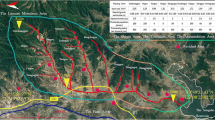Abstract
The study area, located in the southeast of Tibet along the Sichuan-Tibet highway, is a part of Palongzangbu River basin where mountain hazards take place frequently. On the ground of field surveying, historical data and previous research, a total of 31 debris flow gullies are identified in the study area and 5 factors are chosen as main parameters for evaluating the hazard of debris flows in this study. Spatial analyst functions of geographic information system (GIS) are utilized to produce debris flow inventory and parameter maps. All data are built into a spatial database for evaluating debris flow hazard. Integrated with GIS techniques, the fuzzy relation method is used to calculate the strength of relationship between debris flow inventory and parameters of the database. With this methodology a hazard map of debris flows is produced. According to this map, 6.6% of the study area is classified as very high hazard, 7.3% as high hazard, 8.4% as moderate hazard, 32.1% as low hazard and 45.6% as very low hazard or non-hazard areas. After validating the results, this methodology is ultimately confirmed to be available.
Similar content being viewed by others
References
Chengdu Institute of Mountain Hazards and Environment, CAS, Lanzhou Institute of Glacial and Frozen Earth, CAS, Tibet Institute of Communication Science.The Mountain Disasters and Their Countermeasure along the South Line of Sichuan-Tibet Highway [M]. Beijing Science Press, 1995 (Ch).
Parise M. Landslide Mapping Techniques and Their Use in the Assessment of the Landslide Hazard [J].Physics and Chemistry of the Earth, 2001,26: 697–703.
Barredo J I, Benavides A, Hervas J.et al. Comparing Heuristic Landslide Hazard Assessment Techniques Using GIS in the Trijana Basin, Gran Canaria Island, Spain [J].International Journal of Applied Earth Observation and Geoinformation, 2000,2: 9–23.
Gokceoglu C, Aksoy H. Landslide Susceptibility Mapping of the Slopes in the Residual Soils of the Mengen Region (Turkey) by Deterministic Stability Analyses and Image Processing Techniques [J].Engineering Geology, 1996,44: 147–161.
Gregory C O, John C D. Using Multiple Logistic Regression and GIS Technology to Predict Landslide Hazard in Northeast Kansas, USA [J].Engineering Geology, 2003,69: 331–343.
Baeza C, Corominas J. Assessment of Shallow Landslide Susceptibility by Means of Multivariate Statistical Techniques [J].Earth Surface Processes and Landforms, 2001,26: 1251–1263.
Aldo C, Susanna P, Claudio T,et al. A Procedure for Landslide Susceptibility Zonation by the Conditional Analysis Method [J].Geomorphology, 2002,48: 349–364.
Tangestani M H. Landslide Susceptibility Mapping Using Fuzzy Gamma Operation in a GIS, Kakan Catchment Area, Iran [J].Map India 2003: Disaster Management, 2003,1: 7.
Liu J L, Lu X K, Liu G Y. Fuzzy Comprehensive Evaluation Method to Evaluate Debris-flow Hazard Degree [J].Geological Science and Technology Information, 2001,20: 86–88 (Ch).
Pece V G, Paul E G, Piotr J. Integrating a Fuzzyk-Means Classification and a Bayesian Approach for Spatial Prediction of Landslide Hazard [J].Journal of Geographical Systems, 2003,5: 223–251.
Lees B G. Neural Networks Applications in the Geosciences: An Introduction [J].Computers Geosciences, 1996,22: 955–957.
Lee S, Ryu J H, Min K,et al. Landslide Susceptibility Analysis Using GIS and Artificial Neural Network [J].Earth Surface Processes and Landforms, 2003,28: 1361–1376.
Perotto-Baldiviezo H L, Thurow T L, Smith C T,et al. GIS-Based Spatial Analysis and Modeling for Landslide Hazard Assessment in Steeplands, Southern Honduras [J].Agriculture, Ecosystems and Environment, 2004,103: 165–176.
Carrasco R M, Pedraza J, Martin-Duque J F,et al. Hazard Zoning for Landslides Connected to Torrential Floods in the Jerte Valley (Spain) by Using GIS Techniques [J].Natural Hazards, 2003,30: 361–381.
Institute of Mountain Hazards and Environment, CAS, Tibet Institute of Communication Science.A Study of Typical Mountain Hazards along Sichuan-Tibet Highway [M]. Chengdu: Chengdu Science and Technology University Publishing House, 1999: 21–22 (Ch).
Wei F Q, Xie H, Zhong D L.Methods for Zoning Dangerousness of Debris Flow in the Area with Complete Information. Catalogue, Database, Regional Rules of Debris Flows and Landslides [M]. Chengdu: Sichuan Science and Technique Press, 1998: 31–36 (Ch).
Xie H, Zhong D L, Wei F Q,et al. Danger Degree Regionalization in Major Regions of Debris Flow and Landslide Catalogue. Catalogue, Database, Regional Rules of Debris Flows and Landslides [M]. Chengdu: Sichuan Science and Technique Press, 1998: 37–41 (Ch).
Ross T J.Fuzzy Logic with Engineering Applications [M]. New York: McGraw-Hill, 1995.
Author information
Authors and Affiliations
Corresponding author
Additional information
Foundation item: Supported by the Knowledge Innovation Program of Chinese Academy of Sciences (KZCX2-SW-319-01)
Biography: SONG Shujun (1978-), male, Ph.D candidate, research direction: application and development of geographic information system and remote sensing.
Rights and permissions
About this article
Cite this article
Shujun, S., Baolei, Z., Wenlan, F. et al. Using fuzzy relations and GIS method to evaluate debris flow hazard. Wuhan Univ. J. Nat. Sci. 11, 875–881 (2006). https://doi.org/10.1007/BF02830180
Received:
Issue Date:
DOI: https://doi.org/10.1007/BF02830180




